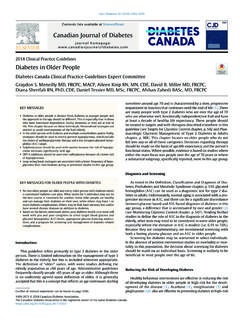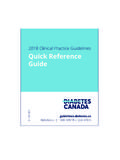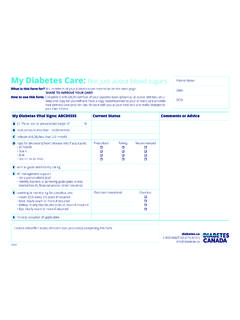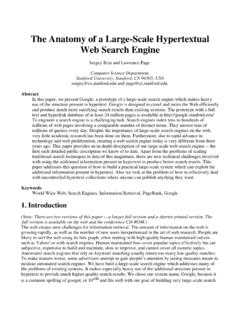Transcription of Insulin Order Sets - Diabetes Canada
1 Insulin Order Sets & In-Hospital Management of Diabetes 416591 Table of ContentsKey elements from Diabetes Canada 2018 Clinical Practice GuidelinesIntroduction .. 1 Hyperglycemia in hospital How common is it? ..1 Preventing Diabetes -related complications in systems improve in-hospital care of patients with Diabetes ? ..2A practical guide to Order set implementation in your hospital How to implement basal-bolus-supplemental Insulin clinical Order set (COS) in your hospital A stepwise a basal-bolus-supplemental Insulin COS in intravenous (IV) Insulin COS.
2 4 How to write an IV Insulin COS .. 4 Frequently asked ..8 Clinical Order setsSample Subcutaneous Insulin Clinical Order Set Adult Inpatient Sample IV Insulin Clinical Order Set Adult Inpatient Acute ..11 Sample Insulin Infusion Clinical Order Set Critical Care Sample Hypoglycemia Clinical Order Set Adult ..15 Sample Insulin Infusion Clinical Order Set Acute Coronary Syndrome: Inital Management ..16 David Miller, MD, FRCPC, Janine Malcom, MD, FRCPC, Catherine Yu, MD, FRCPC, MHSc August 2018 Key elements from Diabetes Canada 2018 Clinical Practice GuidelinesIntroduction:Hyperglycemia is common in hospitalized patients, even in those not previously known to have Diabetes .
3 Common interventions in hospital such as intravenous and oral glucocorticoids, total parenteral nutrition and, enteral feeds can predispose patients to hyperglycemia and subsequent increased risk of adverse outcomes when they lead to hyperglycemia. The primary goal of hospital management of Diabetes is the prevention of short-term complications of Diabetes : symptoms of hyper- and hypoglycemia, prevention of infections, and prevention of surgical complications. This is best achieved with intravenous Insulin for critically ill patients and scheduled basal, bolus, and a correction (supplemental) subcutaneous Insulin program for non-critically ill patients.
4 A systems approach to the hospital care of patients with Diabetes can be associated with improved outcomes. System components demonstrated to improve outcomes include: policies to recognize and treat hypoglycemia, targeted glycemic levels for acutely ill and critically ill patients, Diabetes care teams, and clinic Order sets or computer pharmacy Order entry to facilitate optimal Insulin ordering. Hyperglycemia in hospital How common is it?In a review of the medical records of over 2,000 adult patients admitted to a community teaching hospital in the United States, hyperglycemia was present in 38% of patients.
5 Of these patients, 26% had a known history of Diabetes and 12% had no history of Diabetes prior to admission (Umpierrez, 2002). In a large clinical trial, 39% of patients in an intensive care unit required Insulin treatment because they had one or more blood glucose levels over mmol/L. Of the 783 Insulin requiring subjects, 13% had a pre-existing diagnosis of Diabetes and only 4% had been previously treated with Insulin (van den Berghe, 2001). In a recent paper examining hyperglycemia in steroid treated patients, Fong et al ( 2013) evaluated 80 patients treated with high-dose steroids (prednisone 25 mg / day, dexamethasone 4mg / day, hydrocortisone 100 mg / day, or more) and found 86% with one or more BG > 8 mmol/L and 70% with one or more BG > 10 mmol/L.
6 Among those who developed hyperglycemia, it occurred within the first 48 hours in 94% of subjects. Multiple studies (Olveira, 2013; Pasquel, 2010) have shown that hyperglycemia occurring while on TPN is associated with an increase in multiple adverse outcomes, including death. In the Pasquel study, 10% of subjects had a mean daily blood glucose over mmol/L and 30% had a mean daily blood glucose over mmol/L. Ninety-five per cent of those subjects were treated with Insulin . Preventing Diabetes -related complications in hospital1) Critical CareOne study in critical care patients demonstrated improved outcomes, including decreased mortality, with an intravenous Insulin strategy aiming for blood glucose levels of mmol/L, compared to a strategy aiming for blood glucose levels of mmol/L.
7 The mean morning blood glucose values in the two groups were and mmol/L, respectively (van den Berghe, 2001). However, a subsequent study in critical care patients demonstrated worse outcomes, including increased mortality, with an intravenous Insulin strategy aiming for blood glucose levels of mmol/L, compared to a strategy aiming for blood glucose levels of mmol/L. The mean morning blood glucose values in the two groups were and mmol/L, respectively (Finfer, 2009). In-Hospital Management of Diabetes |1 Therefore, Diabetes Canada s 2018 Clinical Practice Guidelines for the Prevention and Management of Diabetes in Canada (CPGs) recommendation is: 2)Post-operative CABGA systematic review of randomized controlled trials supports the use of intravenous Insulin infusion targeting a blood glucose of to mmol/L over correction only subcutaneous Insulin for perioperative glycemic control in cardiovascular surgery patients.
8 This was demonstrated by a marked reduction in surgical site infections with an odds ratio of (Boreland, 2015).Therefore, the 2018 CPGs recommendation is:3)Post-operative - Non-cardiac surgeryOne clinical trial in a general surgery population compared a basal-bolus-supplemental Insulin program with an aggressive short-acting / correction only (sliding scale) Insulin program. The patients treated with the basal-bolus-correction (supplemental) program had lower blood glucose at all times of day and had 1/3 of the major post-operative complications, compared to patients treated with correction Insulin alone (Umpierrez, 2011).
9 Therefore, the 2018 CPGs recommendation is: 4)General MedicineOne clinical trial in a general medical population compared a basal-bolus-supplement Insulin program with an aggressive short-acting / correction only (sliding scale) Insulin program. The basal-bolus-correction program lowered blood glucose at all times of day without an increase in hypoglycemia. No difference in outcomes was seen (Umpierrez, 2007). Therefore, the 2018 CPGs recommendations are: What systems improve in-hospital care of patients with Diabetes ?
10 An interprofessional team-based approach(Koproski 1997; Mackey, 2014) Health-care professional developmentregarding in-hospital Diabetes management(Moghissi, 2015) Algorithms, Order sets and decision support(Nirantharakumar, 2012; Lin, 2015) Comprehensive quality assurance initiatives,including institution-wide BG monitoringsystems, inpatient education, and transition/continuity of care and discharge planningFor people with Diabetes undergoing CABG, a continuous intravenous Insulin infusion protocol targeting intraoperative glycemic levels between and mmol/L should be used to prevent postoperative most medical/surgical critically ill hospitalized people with Diabetes with hyperglycemia.












